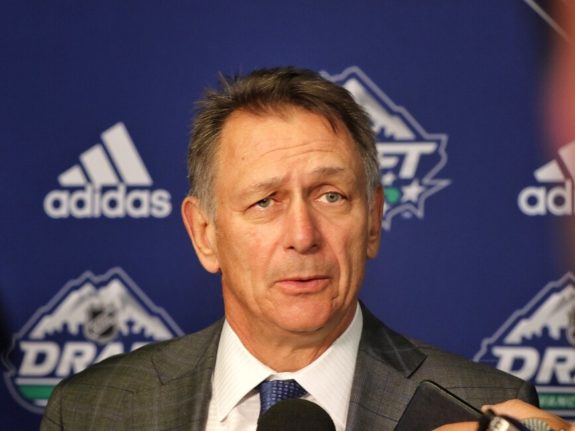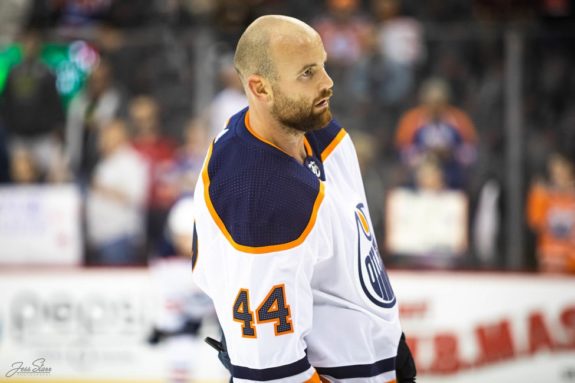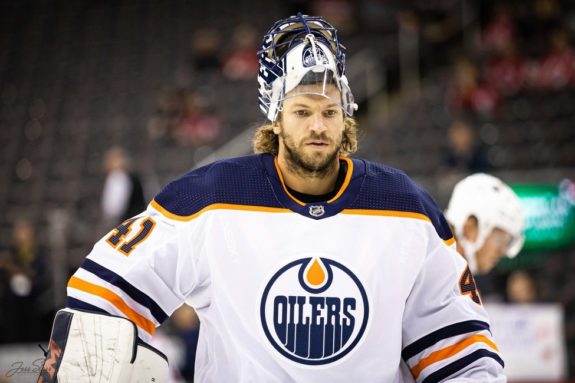The Edmonton Oilers are currently in a cap crunch and operating well into the long-term injured reserve budgets in order to remain salary cap compliant. With Mikko Koskinen, Mike Smith, and Stuart Skinner not being able to provide consistency at the goaltending position this season, the need to acquire a number one goaltender is mounting.
This is a glaring need that the Oilers will need to address next season if they cannot figure out a way to make it happen in 2021-22. In either instance, the replacement will likely eat up a good chunk of cap space. Darnell Nurse’s eight-year contract extension also kicks in next season, which will see his average annual value increase by $3,650,000, further limiting the team’s cap space heading into 2022-23.

The team also needs to make room for likely pay increases to both Kailer Yamamoto and Jesse Puljujarvi, who will be restricted free agents with arbitration rights in the offseason. Addressing these obstacles will require cap space which the Oilers do not have much of, even with the remaining $4.5 million of Koskinen’s contract coming off the books at season’s end. This will leave management with some tough decisions to make, and inevitably some players on the current roster will get moved in order to make cap space.
Zack Kassian – Right Wing
Contract remaining as of 2022-23 season: Two years at $3,200,000 per season.
This one is probably the easiest of the cap casualties to predict, considering the term and dollar value remaining on Kassian’s deal. He brings a lot to the table in terms of physicality and toughness that the team otherwise lacks, but the repercussions of keeping him are just too detrimental to the future of the team.

Since coming to the Oilers from the Vancouver Canucks for the 2015-16 season, Kassian has played in 385 games with 54 goals and 130 points to go along with 930 hits and counting. He’s contributed 19 or more points in five of his seven seasons as an Oiler, including hitting career-highs in goals (15), assists (19), and points (34). As far as his role on the team is concerned, he played as high as the top line alongside Connor McDavid and as low as a fourth-line, including everything in between. Nonetheless, Kassian always provides a source of competitiveness and energy no matter what role he is asked to play.
Related: Oilers’ Kassian Experiment Could Help Kane Turn Things Around
Kassian signed his extension back in Jan. 2020, and at the time, it may not have looked like an overpayment. But as time continues to roll along, it is looking more and more like one. The need for a player like Kassian is necessary, but his salary is simply too much to give to a bottom-six forward in the modern-day NHL. Unfortunately for Kassian, the role he plays is one they can fill with a more cost-effective asset in free agency or more skilled in-house prospect, rather than paying the $3,200,000 salary he is owed for the next two seasons.
Tyson Barrie – Right Defense
Contract remaining as of 2022-23 season: Two years at $4,500,000 per season.
Barrie earned his extension with the Oilers after leading all defensemen in scoring in the 2020-21 season with eight goals and 48 points. He is a great offensive threat and not necessarily a defensive liability, but unfortunately for him, he’s looking expendable in the Oilers’ current situation.
Barrie began the season on the team’s top power-play unit and alongside Nurse on the number one defense pair, but his role is decreasing as the season progresses. His average time on the ice as an Oiler has dropped significantly from the 21:24 he played last season down to 19:45 this season.
The emergence of Evan Bouchard is the primary reason to blame for Barrie’s diminished role on the team, as Bouchard’s play this season is exceeding expectations. Bouchard is known for his offensive abilities, but he’s proving he can do more than just produce offense, which led him to overtake Barrie on the top defense pair. His ability to play the penalty kill also gave him a leg up on Barrie and into Tippett’s good books this year.
Since Barrie missed time with COVID-19, and more recently, an upper-body injury, he is now further behind in the depth chart, with Bouchard receiving more opportunity on the first power-play unit and relishing the opportunity. If Barrie is not going to run the top power-play unit, his role on the team seems more like a luxury rather than a necessity. To continue to pay an offensive defenseman $4,500,000 who is playing on your third defense pair may work this season, but when push comes to shove and cap space gets tight, it’s a role the Oilers can fill at a much more affordable cap hit.
Derek Ryan – Center
Contract remaining as of 2022-23 season: One year at $1,250,000 per season.
It is rare for a team to part ways with a newly acquired player from a management standpoint because it admits an error in judgment, but in the case of Derek Ryan, it may be in the team’s best interest to move on. Ryan signed with Edmonton in the offseason as a free agent from the provincial rival Calgary Flames. He is known for his defensive game and was expected to help the team in the faceoff circle and provide center depth. Unfortunately, he took a step back from his production during the 2020-21 season.

With the team adding some depth by signing Evander Kane, Ryan is now slotted in as the Oilers’ fourth center, with Ryan Nugent-Hopkins moving down to center the third line. If this is where the team wants him playing, there are other centermen available at lower cap hits to fill this role. Like Ryan, Devin Shore is under contract until the end of the 2022-23 season with a cap hit of $850,000 and has five points in 24 games this season compared to Ryan’s six points through 37 games. Aside from similarities in offensive production, Shore also owns a 51 percentage faceoff percentage compared to Ryan’s 56.8 percent.
With the Oilers’ prospect pool looking promising, there is also potential for some young players to force their way into an NHL role next season. Dylan Holloway, in particular, is one who could push for an NHL job next season and potentially be an in-house replacement option to fill the void if Ryan were to be moved out. Despite Ryan’s contract not being overwhelming on the Oilers’ cap situation, every dollar of cap space is precious. And the importance of getting contributions from value contracts is something Edmonton needs in order to make space to address other areas of need.
Mike Smith – Goalie
Contract remaining as of 2022-23 season: One year at $2,200,000 per season.
Mike Smith will be 40 years old heading into the final year of his contract that many believe was one year too long when he signed it. General manager Ken Holland handed Smith a two-year deal after his stellar 2020-21 season, but he’s struggling to stay healthy this season, playing in only six games for the Oilers prior to the All-Star break. This is not the type of season the Oilers thought they would get from Smith, but this is part of the risk that comes when signing an older goaltender.

The cap hit he carries is a sizeable amount, considering his limited contributions to the team this season and the unlikelihood of him being a contributor in the 2022-23 season based on his current trajectory. The Oilers should actively be looking to get this contract and money off their books, but the question is who would take on a 39-year-old netminder who is owed over $2,000,000 in salary.
Related: 4 Timely Trade Targets Oilers Should Consider To Fix Goaltending Issues
One option to address this issue is to move Smith back to his former team in the Arizona Coyotes, where he spent six seasons, along with a pick or prospect to entice them to take on the remaining term on the deal. While it would hurt to give away another asset, it is a viable option and one that would provide more cap flexibility heading into next season. The other option that could take place is for Smith to remain on long-term injured reserve until the end of his contract so that the team would be able to work into the LTIR salary bonus. This would be beneficial for the Oilers in terms of not having to give up an additional asset to move money out.
You may also like:
- Every NHL Team’s Longest-Tenured Player
- Today in Hockey History: April 2
- Oilers’ Trade Deadline Additions Are Making an Impact
- Oilers’ Raphael Lavoie Turning Heads With AHL Condors
- NHL Rumors: Oilers, Blues, Blue Jackets, Red Wings
As the days go by, it becomes increasingly likely that Smith may, in fact, not be able to make a return due to a plethora of different injuries lingering from a storied 16-year career. With Stuart Skinner potentially emerging as the Oilers’ goaltender of the future or a backup goaltender at the very least, the team would be wise to find a way to make Smith’s remaining contract disappear.
Big Decisions Ahead for Oilers Management
Navigating the salary cap should be considered an art, and this is part of what separates the good general managers from the great ones. There will be a limited amount of cap space available to Holland in the offseason with a laundry list of areas that will need to be addressed, which means tough decisions on players will need to be made for the betterment of the team. The need to find players to outperform contract values is at an all-time high, and unfortunately, some players who have become luxuries or are underperforming are ones that are at risk of being moved in the 2022-23 season because of salary cap restraints.